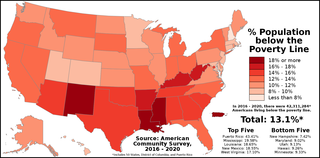 | Back to e-WV
| Back to e-WV
 The West Virginia Encyclopedia
The West Virginia Encyclopedia
 | Back to e-WV
| Back to e-WV
 The West Virginia Encyclopedia
The West Virginia Encyclopedia

West Virginia consistently ranks among the poorest states in the nation. The 2020 Census found that about 278,734, or 16.8 percent, of West Virginians were living below the federal poverty threshold of $26,500 for a family of four—a slight decrease from the 17.4 percent found in the 2010 Census. In 2020, the national poverty rate was 11.4 percent, and West Virginia ranked 46th overall. Childhood poverty has been a particular problem: 23.1 percent of children under 18 live in poverty, ranking West Virginia 44th in the nation. About 29.0 percent of West Virginia children report living in a family that does not get enough to eat or that is behind on its housing payments.
The poverty rate varies widely in different regions of the state. In McDowell, West Virginia’s poorest county and the nation’s 34th poorest, an estimated 31.7 percent of the population lives in poverty (based on per capita personal income), compared to 9.7 percent in Jefferson, the state’s least-poor county.
West Virginia’s poverty rate has fallen in recent decades, from 22.2 percent in 1970 to 17.9 percent in 2022, the third worst rate in the nation. The gap between national and state rates has fluctuated over the period, from 8.5 percent in 1970 to 2.3 percent in 2010, back up to 8.4 percent by 2022.
Poverty activists believe that the situation is worse than the official numbers suggest, arguing that official poverty thresholds do not actually include enough money for today’s families to meet minimum expenses. The thresholds were designed in the 1960s and have been adjusted for inflation but not, critics say, for changing social circumstances. At that time, for example, most families expected to live on one income. Women stayed home with the children. Today, both parents are expected to work, meaning families may have child-care costs, perhaps two cars, and other job-related expenses.
Another useful meter of family well-being is the rate at which children qualify for free or reduced-cost school lunch. About half the state’s public school children received free or reduced-cost lunch in 2020. Again, regions differ. In Jefferson, Monongalia, and Putnam, counties, less than 40 percent of students qualify, the lowest rates in the state. In McDowell County, more than 80 percent qualify. At some individual schools in the state, nearly every child qualifies. In 1954, 6.7 percent of the state’s school children were ‘‘on relief,’’ as a different program was then described. Nationally, only 2.8 percent were. The state’s high rate was attributed to the deaths and unemployment of wage earners in the coalfields.
Some residents bristle at references to poverty. By other measures, West Virginians count themselves wealthy. The 2020 Census found that 75.2 percent of residents owned their homes, up from 72 percent in 1990 and the highest rate in the country. Modest dwellings and mobile homes account for many of these residences.
West Virginia is the only state wholly within Appalachia, as defined by the federal government. Poverty has been one of the region’s enduring characteristics. Periodically, outsiders ‘‘discovered’’ the region and its problems. Some were inspired to help. In 1932, a group called Save the Children began sending food and other necessities to children of miners in Kentucky, and then West Virginia.
In 1933, federal programs encouraged by Eleanor Roosevelt built communities to resettle stranded industrial workers. The government bought land and built houses and entire villages at Arthurdale, in the Tygart Valley, and in Putnam County. The Works Progress Administration and other programs of Franklin Roosevelt’s New Deal administration brought work relief to thousands throughout the state. Old methods of caring for the poor gave way under the onslaught of the Great Depression. Many thousands were impoverished at least temporarily, and the county poor farm system was replaced by modern social welfare agencies.
John F. Kennedy campaigned extensively in West Virginia during the 1960 presidential primary election, again drawing national press attention to the area. Some West Virginians still wince at the February 6, 1960, Saturday Evening Post story that highlighted examples of debilitating poverty within a few steps of ostentatious wealth. Throughout Kennedy’s administration and President Lyndon Johnson’s War on Poverty, federal money flowed into West Virginia for early childhood education, job training, literacy programs, roads, and direct relief for families. Some programs started at that time continue to operate 60 years later.
Historians point out that West Virginians have not been able to share sufficiently in the wealth that they helped to create. For generations, raw materials have been shipped out and expensive finished goods shipped in. Historian Otis Rice noted that the very shape of the land contributed to the state’s economic and cultural conditions. The mountains peak within West Virginia, so major rivers flow away from the center to the borders and into other political and economic regions. As early communications and trade followed water routes, much of the population accumulated near the borders. This feature has given the state little unity. Regions differ down to the contour of the earth and soil types, so that even the industries they support are different. In the Eastern Panhandle and the Ohio River Valley, for example, a significant agricultural economy has survived into the 21st century, which offers little similarity to the long industrialized economies of the Northern Panhandle or the southern coalfields.
Once established, poverty can be self-perpetuating. Habits of dependency develop. Impoverished children are less likely to be healthy and ready for school when they arrive, and more likely to struggle or fail. School frustration or failure may be used to predict teen pregnancy, criminal behavior, idleness, and ultimately being poor. Poverty stresses parents and couples, contributing to domestic violence, mental and physical health issues, and drug and alcohol abuse.
Written by Dawn Miller